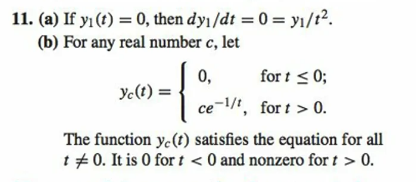11. Consider the differential equation dy dt (a) Show that the constant function yı(t) = 0 is a solution. (b) Show that there are infinitely many other functions that satisfy the differen- tial equation, that agree with this solution when t ≤ 0, but that are nonzero when t > 0. [Hint: You need to define these functions using language like "y(t) = ... when t ≤0 and y(t) = ... when t > 0."] (c) Why doesn't this example contradict the Uniqueness Theorem?
11. Consider the differential equation dy dt (a) Show that the constant function yı(t) = 0 is a solution. (b) Show that there are infinitely many other functions that satisfy the differen- tial equation, that agree with this solution when t ≤ 0, but that are nonzero when t > 0. [Hint: You need to define these functions using language like "y(t) = ... when t ≤0 and y(t) = ... when t > 0."] (c) Why doesn't this example contradict the Uniqueness Theorem?
Advanced Engineering Mathematics
10th Edition
ISBN:9780470458365
Author:Erwin Kreyszig
Publisher:Erwin Kreyszig
Chapter2: Second-order Linear Odes
Section: Chapter Questions
Problem 1RQ
Related questions
Question
I have provided the answer. Part (b), I see how the textbook got the solutions but do not understand how the t values determine the
![11. Consider the differential equation
dy
dt
(a) Show that the constant function yı(t) = 0 is a solution.
(b) Show that there are infinitely many other functions that satisfy the differen-
tial equation, that agree with this solution when t ≤0, but that are nonzero
when t > 0. [Hint: You need to define these functions using language like
"y(t) = ... when t ≤0 and y(t) = ... when t > 0."]
(c) Why doesn't this example contradict the Uniqueness Theorem?](/v2/_next/image?url=https%3A%2F%2Fcontent.bartleby.com%2Fqna-images%2Fquestion%2F652e5396-12b6-4e5e-865e-eecd6b9e3fee%2F3121e684-2674-4bce-819e-242b795327ea%2F8mnjuww_processed.png&w=3840&q=75)
Transcribed Image Text:11. Consider the differential equation
dy
dt
(a) Show that the constant function yı(t) = 0 is a solution.
(b) Show that there are infinitely many other functions that satisfy the differen-
tial equation, that agree with this solution when t ≤0, but that are nonzero
when t > 0. [Hint: You need to define these functions using language like
"y(t) = ... when t ≤0 and y(t) = ... when t > 0."]
(c) Why doesn't this example contradict the Uniqueness Theorem?

Transcribed Image Text:11. (a) If y₁ (t) = 0, then dy₁/dt = 0 = y₁/t².
(b) For any real number c, let
Yc (t) =
{
for t ≤ 0;
ce-¹/1, fort > 0.
0,
The function ye(t) satisfies the equation for all
t = 0. It is 0 for t < 0 and nonzero for t > 0.
Expert Solution
This question has been solved!
Explore an expertly crafted, step-by-step solution for a thorough understanding of key concepts.
This is a popular solution!
Trending now
This is a popular solution!
Step by step
Solved in 2 steps with 2 images

Recommended textbooks for you

Advanced Engineering Mathematics
Advanced Math
ISBN:
9780470458365
Author:
Erwin Kreyszig
Publisher:
Wiley, John & Sons, Incorporated

Numerical Methods for Engineers
Advanced Math
ISBN:
9780073397924
Author:
Steven C. Chapra Dr., Raymond P. Canale
Publisher:
McGraw-Hill Education

Introductory Mathematics for Engineering Applicat…
Advanced Math
ISBN:
9781118141809
Author:
Nathan Klingbeil
Publisher:
WILEY

Advanced Engineering Mathematics
Advanced Math
ISBN:
9780470458365
Author:
Erwin Kreyszig
Publisher:
Wiley, John & Sons, Incorporated

Numerical Methods for Engineers
Advanced Math
ISBN:
9780073397924
Author:
Steven C. Chapra Dr., Raymond P. Canale
Publisher:
McGraw-Hill Education

Introductory Mathematics for Engineering Applicat…
Advanced Math
ISBN:
9781118141809
Author:
Nathan Klingbeil
Publisher:
WILEY

Mathematics For Machine Technology
Advanced Math
ISBN:
9781337798310
Author:
Peterson, John.
Publisher:
Cengage Learning,

